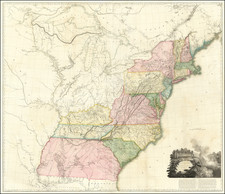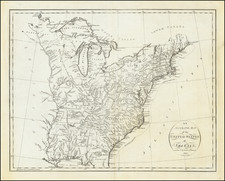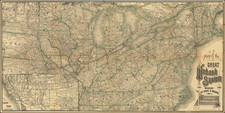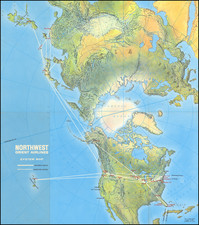Important early railroad map of the United States, which would appear to also be Cram's first map of the United States.
George Cram began publishing maps in 1870 (New Sectional Map of the State of Illinois) and by 1873, he was publishing seperately issued maps of several of states and Territories. Beginning in 1875, Cram issued his first atlas. Cram & Rand McNally would go on to become the primary American atlas publishers of the next 50 years.
The present map would appear to be Cram's first map of the United States. The present example was bound into an incomplete example of Cram's extremely rare 1875 New Commercial Atlas of the United States and Territories (OCLC Lists 1 example). However, examing Rumsey's copy and the complete copy in my personal collection, it would appear that the present map, which is considerably larger than the copies in Rumsey, etc., was likely a separately issued or wall map edition, which is a completely different set of lithographic stones.
George F. Cram (1842-1928), or George Franklin Cram, was an American mapmaker and businessman. During the Civil War, Cram served under General William Tecumseh Sherman and participated in his March to the Sea. His letters of that time are now important sources for historians of the Civil War. In 1867, Cram and his uncle, Rufus Blanchard, began the company known by their names in Evanston, Illinois.
Two years later, Cram became sole proprietor and the company was henceforth known as George F. Cram Co. Specializing in atlases, Cram was one of the first American companies to publish a world atlas. One of their most famous products was the Unrivaled Atlas of the World, in print from the 1880s to the 1950s.
Cram died in 1928, seven years after he had merged the business with that of a customer, E.A. Peterson. The new company still bore Cram’s name. Four years later, the Cram Company began to make globes, a branch of the business that would continue until 2012, when the company ceased to operate. For the final several decades of the company’s existence it was controlled by the Douthit family, who sold it just before the company was shuttered.










![[ Promoting Emigration To The Czech Market ] Ceske Osady V Americe [ A Correct Map of the United States of America Showing Atchison, Topeka and Santa Fe R.R. and Connections ]](https://storage.googleapis.com/raremaps/img/small/101348.jpg)



![(Lasalle's Final Expedition) Dernieres Decouvertes dans L'Amerique Septentrionale de M. De La Sale [i.e., La Salle], Mises au jour par M. le Chevalier Tonti, Gouverneur du Fort Saint Louis, aux Islinois.](https://storage.googleapis.com/raremaps/img/small/69476.jpg)